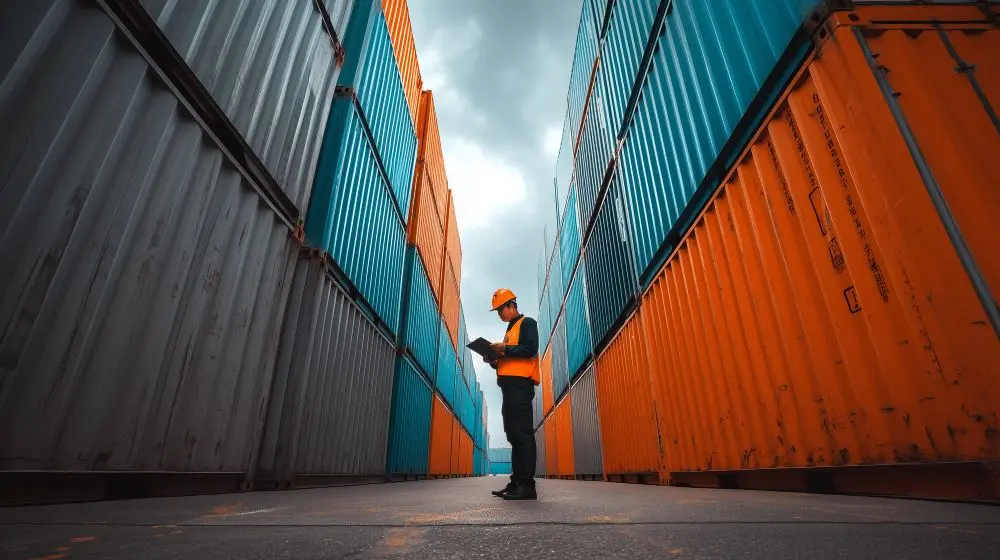- Insights & events
- Blog

Blog | October 20, 2025
Thriving beyond tariff turbulence: strategic cost reduction in global supply chains
A supply chain transformation Q&A
As transportation costs climb and supply chains grow increasingly complex — impacted by tariff volatility, geopolitical uncertainty and regulatory pressure — organizations are being pushed to optimize logistics operations more strategically than ever. The goal is no longer just maintaining performance across global networks but also reducing costs, improving efficiency, driving performance levels and operating more sustainably.
While the challenges are real, so is the opportunity. With the right combination of digital tools, advanced technologies and trusted partners, companies can simplify complexity, reduce structural transportation costs and build more agile, future-ready supply chains.
We're seeing a clear shift toward digital transformation, end-to-end visibility and budget-conscious decision-making. Logistics leaders and organizations who are moving quickly aren’t just keeping pace, they’re setting it. With artificial intelligence, automation and connected platforms, businesses are gaining the insight and flexibility needed to navigate disruption and unlock long-term value.
This builds on themes we explored in Thriving Beyond Tariff Turbulence, where we looked at how shifting trade policies and tariff pressures are reshaping supply chain strategies.
In this second part of our discussion, we reconnect again with industry expert Greg Toornman, former global vice president of materials management, logistics and demand planning at AGCO Corporation and now a strategic advisor with 4flow. With decades of experience leading global supply chain transformation, Greg offers a practical perspective on how organizations are reducing structural transportation costs, embedding sustainability into logistics strategy and using data-driven planning to drive measurable efficiency. He shares how AI is reshaping decision-making, what leading companies are doing to streamline operations and why now is the time to act . These insights not only support immediate operational performance improvements but also serve as a valuable foundation for 2026 planning and budgeting, helping align investments with long-term goals for efficiency, resilience and cost control.


Interviewee
Greg Toornman, 4flow Strategic Advisor
What role does AI play in cutting logistics costs and improving budget efficiency?
Greg: AI is no longer a futuristic concept in logistics. It's real and it’s already reshaping how supply chains operate, especially when it comes to reducing costs, driving performance and improving planning accuracy. With AI, logistics teams can forecast more precisely, automate repetitive tasks and optimize routes to minimize fuel usage and shipping delays.
AI helps reduce wasted time and unnecessary spending by enabling faster and more accurate data-driven decisions. Whether you're consolidating loads, choosing lower-cost transportation modes or avoiding surcharge-heavy regions, AI helps you cut costs without compromising service levels.
What’s powerful about AI is that it not only improves efficiency but also makes supply chains more resilient, proactive and adaptive. By leveraging AI, organizations can shift from reactive firefighting to proactive cost management, a change that delivers measurable impact on the bottom line and operating performance levels.
Global logistics seems more complex than ever. How can businesses simplify operations and reduce costs?
Greg: You're right — the complexity we’re seeing now isn’t temporary. It’s the new normal. Simplifying operations requires a combination of tools, strategic thinking and collaboration. When you break it down, here’s how forward-thinking companies are simplifying and saving:
-
Real-time visibility
When you know where your shipments are and what’s causing delays, you can avoid costly rework or expedited freight. IoT sensors and AI-powered platforms give that visibility. That transparency helps teams catch disruptions before they escalate.
-
Automation and AI
Automation and AI, through robotics, machine learning and predictive analytics, enables companies to accelerate operations while optimizing warehouse management, transportation, risk management and demand forecasting.
-
Strategic partnerships
No one can do this alone. Leaning on trusted partners and providers helps control spend, scale efficiently and navigate regulatory hurdles.
-
Optimized transportation networks
Smart transportation planning lets companies switch from air to rail or road, combine shipments or reduce empty miles, all of which cut fuel and carrier costs.
-
Regulatory compliance and risk management
AI platforms simplify complex trade rules and restrictions, tariffs and customs processes to support smoother cross-border operations in a more efficient and standardized process-oriented approach.
-
Sustainable logistics
More companies are adopting green supply chain practices, such as electric fleets, carbon-neutral shipping and smarter packaging, to reduce environmental impact and operating costs.
However, these aren’t one-time initiatives. They’re the structural foundation of a logistics strategy that can scale and evolve with market demands. These actions help cut waste, optimize spend and build a leaner, more responsive logistics network that delivers value to the value chain.
Are there organizations already putting this into action?
Greg: Absolutely. Some of the most innovative companies outside the logistics space are already adopting next-generation transportation management systems (TMS). These platforms help improve efficiency, reduce costs, increase performance levels and provide real-time visibility across networks.
-
Retail and e-commerce
Amazon and Walmart use advanced TMS tools and solutions to leverage network complexity as a method to manage last-mile delivery, warehouse operations and inventory management.
-
Manufacturing
Siemens and General Electric are connecting TMS with supply chain automation to improve raw material sourcing and distribution.
-
Healthcare and pharma
Pfizer and Johnson & Johnson use TMS for cold chain logistics for temperature-sensitive medical supplies.
-
Technology and electronics
Apple and Dell use TMS to streamline global component sourcing, reduce cost, delays and improve coordination.
-
Automotive
Tesla and Ford are integrating transportation planning into production systems for seamless parts movement across global operations.
These organizations demonstrate that AI-driven cloud-based platforms are no longer optional. Rather, they’re essential for staying agile and competitive. With the right tools in place, logistics shifts from being a cost center to a strategic driver of savings and value.
What’s your advice to logistics leaders looking ahead?
Greg: Start now. The longer you wait, the harder it is to catch up. The companies winning today aren’t reacting to disruption but they’re planning for it. Smart budget planning in logistics starts with one core principle: transparency. If you can’t see your costs clearly, whether fuel, tariffs, detention fees, delays,… the list goes on, you can’t control them.
Invest in systems that provide end-to-end cost visibility using AI and automation where they add value. When you have a clear picture of your logistics spend, you can make faster, more informed decisions and hold both internal teams and external partners accountable.
Second, prioritize flexibility. Build transportation networks that can shift modes, lanes or carriers based on performance and cost. Agility in your network design can help avoid costly bottlenecks and take advantage of lower-cost alternatives when they arise.
Third, embed sustainability into your logistics planning. The right initiatives, such as— smarter packaging, electric fleet pilots and improved load density, don’t just reduce emissions; they can also deliver long-term savings and prepare your organization for growing regulatory demands.
Simplifying complexity isn’t about eliminating it. It’s about managing it more effectively. That’s where real opportunity lives.
Looking ahead
As complexity continues to define global logistics, companies that embrace AI, automation and strategic simplification are better positioned to lead. The goal isn’t to eliminate disruption. The goal is to outpace disruption with smarter decisions, better visibility and supply chains built for change.
Greg’s insights underscore a clear message: the logistics leaders of tomorrow are already moving today. By investing in the right platforms, building trusted partnerships and removing unnecessary friction, they’re turning disruption into advantage.
The future of supply chain logistics isn’t about waiting for stability but building it through innovation. And now is the time to get started.
Ready to transform your supply chain for what’s next and reduce costs?
At 4flow, we’re committed to helping supply chains move from complexity to clarity, from disruption to advantage. If you’re exploring new supply chain solutions or refreshing your strategy, let’s connect for a 25-minute planning session.
Interviewer


Samantha Johnston
4flow Content Marketing Specialist





















